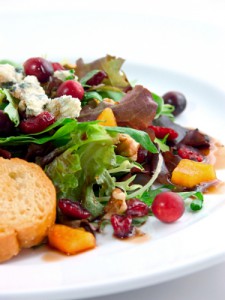We learned last week that it’s better to get your vitamins from food instead of pills.
 But how do you do that? I figured there was no way to get enough of the recommended daily allowance from my diet. Don’t I need to eat a ton of vegetables to get all the vitamins I need?
But how do you do that? I figured there was no way to get enough of the recommended daily allowance from my diet. Don’t I need to eat a ton of vegetables to get all the vitamins I need?
I asked two of UVA’s experts, Wendy Phillips, clinical nutrition director, and Kendra Glassman, a clinical dietitian, for their advice.
It turns out, I can get everything I need if I follow one basic guideline: Eat right.
Put the Right Foods on Your Plate
Eat right? What exactly does that mean? According to Glassman, following the U.S. Department of Agriculture’s current nutrition guide, MyPlate, ensures you’ll get all the vitamins you need.
This means your daily diet should include:
- 50% fruits and vegetables
- 30% grains, especially whole grains
- 20% protein, like lean meats, nuts and beans
- Plus, a cup of dairy products
“If you’re following MyPlate, then you’re going to get a wide variety of foods that provide all the vitamins and minerals you need,” says Glassman.
Getting your vitamins from food also provides you with extras you just can’t get from a pill, says Phillips. Antioxidants and phytochemicals occur naturally in our food and may reduce our risk of cancers, heart disease and other conditions. Stanols and sterols found in plant-based foods lower cholesterol and reduce inflammation.
Get Vitamins From Your Food
The fruits, vegetables and whole grains nature provides for us really are some of the best preventive medicine you can get.
“It is easier to pop a pill. But you’re not getting the same results,” says Phillips.
Are there exceptions to this rule?
Yes, but not very many. It’s better to take these supplements in pill form, depending on your situation:
- Folic acid: Women of child-bearing age need folic acid, but it’s more easily absorbed in pill form than in its natural form, folate. (Check back here in two weeks to find out more about folic acid and prenatal vitamins.)
- Vitamin B12: People who are B12-deficient because of loss of stomach acids need to take the vitamin in pill form. This includes people who’ve had gastric bypass and those taking proton-pump inhibitors (PPIs) and other acid reducers, says Phillips.
Shining a Light on Vitamin D Deficiency
A lot of Americans are vitamin D-deficient. We don’t get enough because we wear sunblock and stay out of the sun, or we’re indoors a lot during the winter. As with any vitamin issues, the best advice is to talk to your doctor, says Phillips. You can have a blood test to determine if you need to add vitamin D to your diet or take a supplement.
Some Vitamin-Rich Food Tips and Snack Ideas
Here are a few of Glassman’s tips for getting vitamins in your diet while following the MyPlate chart:
- Start with vegetables: Plan your meals around vegetables instead of meat.
- Eat a wide range of colors: You’ll get a variety of vitamins with different colors of vegetables and fruits.
- Eat in season: “The highest amount of vitamins and minerals are in foods that are in season,” she says.
- Buy frozen: If a particular food isn’t in season, frozen is better than canned varieties, which are usually high in salt.
Snacks That Are Good for You
Too busy for planning big meals? You can also try these vitamin-rich snacks while you’re at work or on the go:
- Fruits like oranges, bananas, apples and pears
- Low-fat yogurt
- Veggies like grape tomatoes, carrots and celery
- Plain popcorn
- Walnuts and almonds (in small portions)
Why these snacks? Veggies are rich in vitamins A and B, fruits give you vitamin C, dairy is high in vitamin D and whole grains provide you with vitamin B1.
Check With Your Doctor
Talk to your doctor about vitamins and your diet. Everyone is different, and there may be reasons why you need a particular supplement.
Also, if you’re getting anything above the 100% recommended daily allowance for any vitamin, you should talk to your doctor, says Glassman. Some vitamins can interact with other medications you take, especially at higher doses.
More About MyPlate
We took an in-depth look at MyPlate and the changes to the government’s nutritional guidelines last year.
Next Week: Check back here for some healthy, vitamin-rich recipes!
No one seems to take into account that because of poor farming practices, there are NOT the same amounts of vitamins and minerals in food that we used to have. I am sorry I can’t quote the exact source, but I have read that to get the same nutrients in one cup of Spinach as they got in the 1940’s, you would have to eat several bushels now.